Building the Trumpeter 1/350 USS Hornet with Tom's Modelworks Fittings |  | Introduction I know a lot of modelers around the world were excited when Trumpeter released a large 1/350 kit of the CV8 Hornet. I reviewed this kit and Tom's Modelworks excellent Hornet detail set in the December 2002 issue of Internet Modeler. After which I was chomping at the bit to get after this beast and wasted no time in starting. Read on. Building Hornet 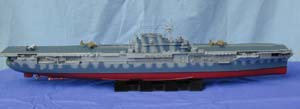 I planned to employ several basic techniques to add details to the model. I tend to build large projects in subassemblies so I examined both the kit and Tom's details instructions to form a plan. I would deal with the flight deck first, then the hull, island, ship's boats and so on in stages to break up a large build into smaller chunks. This method can also simplify painting as you go through the build. Here we go. I planned to employ several basic techniques to add details to the model. I tend to build large projects in subassemblies so I examined both the kit and Tom's details instructions to form a plan. I would deal with the flight deck first, then the hull, island, ship's boats and so on in stages to break up a large build into smaller chunks. This method can also simplify painting as you go through the build. Here we go.  One thing of note is that Tom's instructions rely highly on Warship Pictorial Number 9 Yorktown Class Carriers for details. You should really pick this up if you want to do justice to the model. I thank our esteemed Editor for lending me his copy for this build! One thing of note is that Tom's instructions rely highly on Warship Pictorial Number 9 Yorktown Class Carriers for details. You should really pick this up if you want to do justice to the model. I thank our esteemed Editor for lending me his copy for this build! The Main Decks and Hull I went over the instructions. They have nicely done exploded views with all parts identified. I quickly realized that the three-part flight and hanger decks were the first hurdles to overcome. This alone precludes following the direction steps as presented. Fortunately fit was good on both decks and only required filling and judicious sanding until the huge flight deck looked uniform from bow to stern. Whew! I masked off the flight deck around the seams to save that great inlaid detail. I then assembled, painted, and added the flight deck under components to finish this stage. 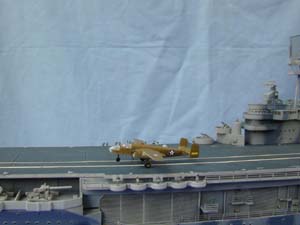 I was planning a Measure 12 modified camo scheme for the ship as I was going to depict the ship at the time of the Tokyo raid. At this point I shot the flight deck with light gray. I then carefully masked the deck striping and shot the surface with Poly Scale deck blue. After this dried I pulled up the masking and touched up the stripes a tad. I wanted to add depth to the acres of flight deck so I did an oil wash followed up with light dry brushing with light gray. I shot the hanger deck with dark nonskid gray. I was planning a Measure 12 modified camo scheme for the ship as I was going to depict the ship at the time of the Tokyo raid. At this point I shot the flight deck with light gray. I then carefully masked the deck striping and shot the surface with Poly Scale deck blue. After this dried I pulled up the masking and touched up the stripes a tad. I wanted to add depth to the acres of flight deck so I did an oil wash followed up with light dry brushing with light gray. I shot the hanger deck with dark nonskid gray. 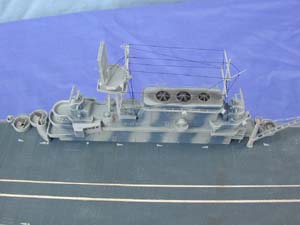 I wanted to do the kit full-hull so I joined the massive upper and lower hull pieces with tape and adjusted fit until things lined up. Choosing my battle, I matched the pieces at the bow and then work my way after using the capillary method of applying glue. Things fit pretty well until I got to the stern where the lower hull overlapped slightly. I filled the long seams with putty and sanded until I was happy with the look. The stern took extensive filling and sanding to achieve a nice fit. I wanted to do the kit full-hull so I joined the massive upper and lower hull pieces with tape and adjusted fit until things lined up. Choosing my battle, I matched the pieces at the bow and then work my way after using the capillary method of applying glue. Things fit pretty well until I got to the stern where the lower hull overlapped slightly. I filled the long seams with putty and sanded until I was happy with the look. The stern took extensive filling and sanding to achieve a nice fit. 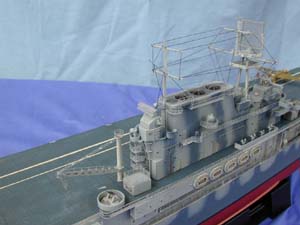 Of course the proof is in the painting so I shot the hull with Tamiya haze gray. I then masked the hull and sprayed on a flat black waterline. I then assembled the ship's rudder and drive shafts as called for in step 15. After masking one more time I then shot the lower hull with Tamiya dark red and let things dry. Of course the proof is in the painting so I shot the hull with Tamiya haze gray. I then masked the hull and sprayed on a flat black waterline. I then assembled the ship's rudder and drive shafts as called for in step 15. After masking one more time I then shot the lower hull with Tamiya dark red and let things dry. At this point I was ready to apply the second camo color to the upper hull. The color illustration and most photographs indicate that this expansive wavy design was hard edged. I decided that this was a masking job I was not interested in! I masked the hull at the water line and roughed in the pattern on the deck with a pencil. I then applied Polly Scale Navy blue free hand with an airbrush without a net! The Hanger Deck and Bulkheads 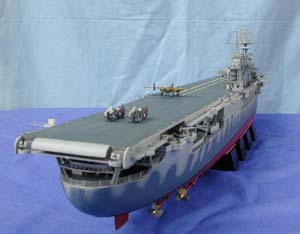 I laid the pre-painted flight deck, fore, and aft decks into the hull. I could see right away that there are some seam issues involve between the decks and hull. I clamped and taped the hull extensively to minimize this and glued as I went. Once things dried I filled in the areas that were most visible and touched up the paint. Man this model is huge! I laid the pre-painted flight deck, fore, and aft decks into the hull. I could see right away that there are some seam issues involve between the decks and hull. I clamped and taped the hull extensively to minimize this and glued as I went. Once things dried I filled in the areas that were most visible and touched up the paint. Man this model is huge! I went through steps 2 through 8 and assembled the various walkways and such to the hanger bulkheads while they were still on the sprue. I then shot everything with haze gray. Once this was dry I followed instructions to assemble the bow and aft deck details. I used a cheap thin necklace material for the anchor chain. I sprayed the chain flat black and CAed them in place. I then assembled the hangar bulkheads to the deck following steps 2 through 8. Here again I found some fill issues with seams but nothing to whine about. I had zero touchup between bulkheads and deck using this method. I left off the ship's guns and boats at this point. 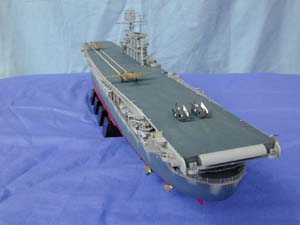 I then carefully dry fit the humongous flight deck to the hanger bulkheads. It wasn't bad in most areas but did have fit problems on the aft starboard section of the ship - the bulkhead slightly protruded under the flight deck. The only thing to do to correct this was to do some minor surgery on the bulkheads to bring them inboard slightly. To heck with that, so I just glued things together, filled, and touched up with haze gray. I then carefully dry fit the humongous flight deck to the hanger bulkheads. It wasn't bad in most areas but did have fit problems on the aft starboard section of the ship - the bulkhead slightly protruded under the flight deck. The only thing to do to correct this was to do some minor surgery on the bulkheads to bring them inboard slightly. To heck with that, so I just glued things together, filled, and touched up with haze gray. The Island I assembled the ship's island and deck structures following steps 10 through 13, cleaned up seams, and shot everything with haze gray. I then applied the wavy Navy blue camo scheme to the island freehand with an airbrush. At this point I went to Tom's details instruction sheet. I had pre-painted the PE haze gray. I added extensive railings to the island following Tom's instructions. I basically crossed off the assembly steps as I went through the rest of the build. 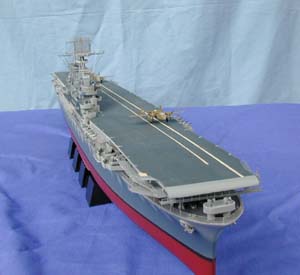 I then assembled the ships masts following step 12. Use care with the main mast assembly, as there are some alignment issues when you place it on the island. I got mine close but the assembly "wants" to lean forward as the parts fit. I then assembled the ships masts following step 12. Use care with the main mast assembly, as there are some alignment issues when you place it on the island. I got mine close but the assembly "wants" to lean forward as the parts fit. I next assembled Tom's radar antennae and added them to the island. I fudged on the air search radar and went with the impressive CXAM array that was actually used after the Tokyo mission. Hey, I am having fun here! I then rigged the island masts with darkened .006 brass wire using Tom's illustration as a guide. I added just enough wires to "represent" the rigging without killing myself. Details, Details 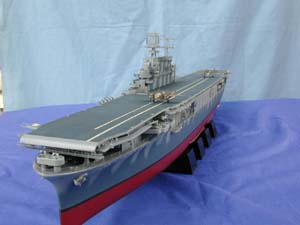 At this point I just let Tom's Details assembly steps drive the rest of the build. I will just hit the highlights here. The kit comes with a multitude of ship boats. I decided to do them all at once. I assembled them using Tom's PE inserts and railings and shot them haze gray. They look pretty sharp if I do say so myself. At this point I just let Tom's Details assembly steps drive the rest of the build. I will just hit the highlights here. The kit comes with a multitude of ship boats. I decided to do them all at once. I assembled them using Tom's PE inserts and railings and shot them haze gray. They look pretty sharp if I do say so myself. I assembled the main ship's crane using the kit base and Tom's PE. I scratched the ship's PA speakers using sprue and Tom's PE faceplates. I added the various PE antennae and direction finders. I just went down Tom's directions until I had all the components added and check off. The ship's 20mm guns are so-so but I used them for the build. You will enjoy putting on a gazillion PE gun shields on these babies! (And then putting them back on as you knock them off!) Final Assembly 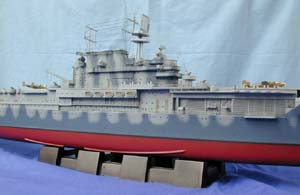 I wrapped things up by installing the island and other deck detail on the flight deck. Fit was perfect so again no touch up between bulkheads and deck. I laid down the numerous PE arrestor deck plate covers following Tom's guide. I left these haze gray so they would show up. I wrapped things up by installing the island and other deck detail on the flight deck. Fit was perfect so again no touch up between bulkheads and deck. I laid down the numerous PE arrestor deck plate covers following Tom's guide. I left these haze gray so they would show up. With everything pretty well built I added the deck railings working from the inside out. There is a ton of railings to put on so take it in stages. Thankfully there are few complex bends to deal with. At one point I thought I would run out of railings but old Tom planned pretty well. There were just enough! I then added the kit-supplied decals. Assembly complete! The Air Department 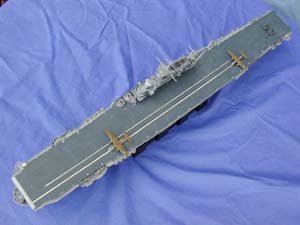 Kit aircraft includes: (two each) B-25 Mitchell bombers, F4F Wildcats, SBD Dauntless dive-bombers, and TBD Devastator torpedo planes. I chose to build the B-25s and F4Fs for this mission. Each aircraft has very finely scribed details even to the point of representing the fabric control surfaces. These are some of the best in scale birds I have seen. I posed one B-25 lifting off with the other revving up at the start off point. I built the F4Fs with wings folded and placed them on the aft elevator as CAP fighters on the way! Aircraft decals are nicely done and went on without a hitch. Trumpeter has now come out with ten packs of each of these aircraft and I am sorely tempted to add to the B25 flock! Kit aircraft includes: (two each) B-25 Mitchell bombers, F4F Wildcats, SBD Dauntless dive-bombers, and TBD Devastator torpedo planes. I chose to build the B-25s and F4Fs for this mission. Each aircraft has very finely scribed details even to the point of representing the fabric control surfaces. These are some of the best in scale birds I have seen. I posed one B-25 lifting off with the other revving up at the start off point. I built the F4Fs with wings folded and placed them on the aft elevator as CAP fighters on the way! Aircraft decals are nicely done and went on without a hitch. Trumpeter has now come out with ten packs of each of these aircraft and I am sorely tempted to add to the B25 flock! Conclusion 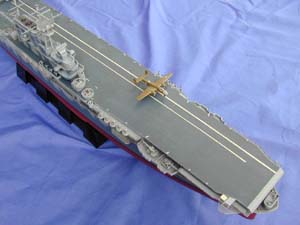 It is so great to have a large scale Yorktown class carrier that is relatively economical! Despite the minor warts, I recommend this kit to most ship lovers. Average level ship builders would have a lot of fun building this right out of the box. It builds up to an impressive representation of this historic ship. You might want to get an easier PE job under your belt if you are planning to use Tom's PE details. They are first rate and easy to work with but there is a ton of PE to build into this ship. It is so great to have a large scale Yorktown class carrier that is relatively economical! Despite the minor warts, I recommend this kit to most ship lovers. Average level ship builders would have a lot of fun building this right out of the box. It builds up to an impressive representation of this historic ship. You might want to get an easier PE job under your belt if you are planning to use Tom's PE details. They are first rate and easy to work with but there is a ton of PE to build into this ship. Thanks to Stevens International and Tom's Modelworks for supplying review samples for this article. | 







|
 I planned to employ several basic techniques to add details to the model. I tend to build large projects in subassemblies so I examined both the kit and Tom's details instructions to form a plan. I would deal with the flight deck first, then the hull, island, ship's boats and so on in stages to break up a large build into smaller chunks. This method can also simplify painting as you go through the build. Here we go.
I planned to employ several basic techniques to add details to the model. I tend to build large projects in subassemblies so I examined both the kit and Tom's details instructions to form a plan. I would deal with the flight deck first, then the hull, island, ship's boats and so on in stages to break up a large build into smaller chunks. This method can also simplify painting as you go through the build. Here we go. One thing of note is that Tom's instructions rely highly on Warship Pictorial Number 9 Yorktown Class Carriers for details. You should really pick this up if you want to do justice to the model. I thank our esteemed Editor for lending me his copy for this build!
One thing of note is that Tom's instructions rely highly on Warship Pictorial Number 9 Yorktown Class Carriers for details. You should really pick this up if you want to do justice to the model. I thank our esteemed Editor for lending me his copy for this build!  I was planning a Measure 12 modified camo scheme for the ship as I was going to depict the ship at the time of the Tokyo raid. At this point I shot the flight deck with light gray. I then carefully masked the deck striping and shot the surface with Poly Scale deck blue. After this dried I pulled up the masking and touched up the stripes a tad. I wanted to add depth to the acres of flight deck so I did an oil wash followed up with light dry brushing with light gray. I shot the hanger deck with dark nonskid gray.
I was planning a Measure 12 modified camo scheme for the ship as I was going to depict the ship at the time of the Tokyo raid. At this point I shot the flight deck with light gray. I then carefully masked the deck striping and shot the surface with Poly Scale deck blue. After this dried I pulled up the masking and touched up the stripes a tad. I wanted to add depth to the acres of flight deck so I did an oil wash followed up with light dry brushing with light gray. I shot the hanger deck with dark nonskid gray.  I wanted to do the kit full-hull so I joined the massive upper and lower hull pieces with tape and adjusted fit until things lined up. Choosing my battle, I matched the pieces at the bow and then work my way after using the capillary method of applying glue. Things fit pretty well until I got to the stern where the lower hull overlapped slightly. I filled the long seams with putty and sanded until I was happy with the look. The stern took extensive filling and sanding to achieve a nice fit.
I wanted to do the kit full-hull so I joined the massive upper and lower hull pieces with tape and adjusted fit until things lined up. Choosing my battle, I matched the pieces at the bow and then work my way after using the capillary method of applying glue. Things fit pretty well until I got to the stern where the lower hull overlapped slightly. I filled the long seams with putty and sanded until I was happy with the look. The stern took extensive filling and sanding to achieve a nice fit.  Of course the proof is in the painting so I shot the hull with Tamiya haze gray. I then masked the hull and sprayed on a flat black waterline. I then assembled the ship's rudder and drive shafts as called for in step 15. After masking one more time I then shot the lower hull with Tamiya dark red and let things dry.
Of course the proof is in the painting so I shot the hull with Tamiya haze gray. I then masked the hull and sprayed on a flat black waterline. I then assembled the ship's rudder and drive shafts as called for in step 15. After masking one more time I then shot the lower hull with Tamiya dark red and let things dry. I laid the pre-painted flight deck, fore, and aft decks into the hull. I could see right away that there are some seam issues involve between the decks and hull. I clamped and taped the hull extensively to minimize this and glued as I went. Once things dried I filled in the areas that were most visible and touched up the paint. Man this model is huge!
I laid the pre-painted flight deck, fore, and aft decks into the hull. I could see right away that there are some seam issues involve between the decks and hull. I clamped and taped the hull extensively to minimize this and glued as I went. Once things dried I filled in the areas that were most visible and touched up the paint. Man this model is huge!  I then carefully dry fit the humongous flight deck to the hanger bulkheads. It wasn't bad in most areas but did have fit problems on the aft starboard section of the ship - the bulkhead slightly protruded under the flight deck. The only thing to do to correct this was to do some minor surgery on the bulkheads to bring them inboard slightly. To heck with that, so I just glued things together, filled, and touched up with haze gray.
I then carefully dry fit the humongous flight deck to the hanger bulkheads. It wasn't bad in most areas but did have fit problems on the aft starboard section of the ship - the bulkhead slightly protruded under the flight deck. The only thing to do to correct this was to do some minor surgery on the bulkheads to bring them inboard slightly. To heck with that, so I just glued things together, filled, and touched up with haze gray.  I then assembled the ships masts following step 12. Use care with the main mast assembly, as there are some alignment issues when you place it on the island. I got mine close but the assembly "wants" to lean forward as the parts fit.
I then assembled the ships masts following step 12. Use care with the main mast assembly, as there are some alignment issues when you place it on the island. I got mine close but the assembly "wants" to lean forward as the parts fit. At this point I just let Tom's Details assembly steps drive the rest of the build. I will just hit the highlights here. The kit comes with a multitude of ship boats. I decided to do them all at once. I assembled them using Tom's PE inserts and railings and shot them haze gray. They look pretty sharp if I do say so myself.
At this point I just let Tom's Details assembly steps drive the rest of the build. I will just hit the highlights here. The kit comes with a multitude of ship boats. I decided to do them all at once. I assembled them using Tom's PE inserts and railings and shot them haze gray. They look pretty sharp if I do say so myself.  I wrapped things up by installing the island and other deck detail on the flight deck. Fit was perfect so again no touch up between bulkheads and deck. I laid down the numerous PE arrestor deck plate covers following Tom's guide. I left these haze gray so they would show up.
I wrapped things up by installing the island and other deck detail on the flight deck. Fit was perfect so again no touch up between bulkheads and deck. I laid down the numerous PE arrestor deck plate covers following Tom's guide. I left these haze gray so they would show up.  Kit aircraft includes: (two each) B-25 Mitchell bombers, F4F Wildcats, SBD Dauntless dive-bombers, and TBD Devastator torpedo planes. I chose to build the B-25s and F4Fs for this mission. Each aircraft has very finely scribed details even to the point of representing the fabric control surfaces. These are some of the best in scale birds I have seen. I posed one B-25 lifting off with the other revving up at the start off point. I built the F4Fs with wings folded and placed them on the aft elevator as CAP fighters on the way! Aircraft decals are nicely done and went on without a hitch. Trumpeter has now come out with ten packs of each of these aircraft and I am sorely tempted to add to the B25 flock!
Kit aircraft includes: (two each) B-25 Mitchell bombers, F4F Wildcats, SBD Dauntless dive-bombers, and TBD Devastator torpedo planes. I chose to build the B-25s and F4Fs for this mission. Each aircraft has very finely scribed details even to the point of representing the fabric control surfaces. These are some of the best in scale birds I have seen. I posed one B-25 lifting off with the other revving up at the start off point. I built the F4Fs with wings folded and placed them on the aft elevator as CAP fighters on the way! Aircraft decals are nicely done and went on without a hitch. Trumpeter has now come out with ten packs of each of these aircraft and I am sorely tempted to add to the B25 flock!  It is so great to have a large scale Yorktown class carrier that is relatively economical! Despite the minor warts, I recommend this kit to most ship lovers. Average level ship builders would have a lot of fun building this right out of the box. It builds up to an impressive representation of this historic ship. You might want to get an easier PE job under your belt if you are planning to use Tom's PE details. They are first rate and easy to work with but there is a ton of PE to build into this ship.
It is so great to have a large scale Yorktown class carrier that is relatively economical! Despite the minor warts, I recommend this kit to most ship lovers. Average level ship builders would have a lot of fun building this right out of the box. It builds up to an impressive representation of this historic ship. You might want to get an easier PE job under your belt if you are planning to use Tom's PE details. They are first rate and easy to work with but there is a ton of PE to build into this ship.






